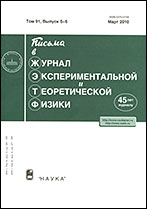|
|
Pis'ma v Zhurnal Èksperimental'noi i Teoreticheskoi Fiziki, 2004, Volume 80, Issue 8, Pages 619–622
(Mi jetpl2150)
|
 |
|
 |
This article is cited in 22 scientific papers (total in 22 papers)
CONDENSED MATTER
Visible photoluminescence from silicon nanopowders produced by silicon evaporation in a high-power electron beam
M. D. Efremova, V. A. Volodina, D. V. Marina, S. A. Arzhannikovaa, S. V. Goryainovb, A. I. Korchaginc, V. V. Cherepkovc, A. V. Lavrukhinc, S. N. Fadeevc, R. A. Salimovc, S. P. Bardakhanovd
a Institute of Semiconductor Physics of SB RAS, Novosibirsk
b Institute of Mineralogy and Petrology, Siberian Branch RAS, Novosibirsk
c G I. Budker Institute of Nuclear Physics, Siberian Branch of Russian Academy of Sciences, Novosibirsk
d Institute of Theoretical and Applied Mechanics, Siberian Branch of the Russian Academy of Sciences, Novosibirsk
Abstract:
Silicon nanopowders produced by electron-beam-induced evaporation of a bulk silicon sample in an argon atmosphere are studied by the photoluminescence technique and Raman scattering spectroscopy. A photoluminescence peak in the visible region of the spectrum has been detected at room temperature in powders consisting of silicon nanocrystals. The strong short-wavelength shift of the photoluminescence peak can be attributed to the quantum size effect of electrons and holes in small silicon nanocrystals (about 2 nm). The size of silicon nanocrystals is determined by analyzing Raman spectra, and it is consistent with estimates obtained from photoluminescence data.
Received: 06.09.2004
Citation:
M. D. Efremov, V. A. Volodin, D. V. Marin, S. A. Arzhannikova, S. V. Goryainov, A. I. Korchagin, V. V. Cherepkov, A. V. Lavrukhin, S. N. Fadeev, R. A. Salimov, S. P. Bardakhanov, “Visible photoluminescence from silicon nanopowders produced by silicon evaporation in a high-power electron beam”, Pis'ma v Zh. Èksper. Teoret. Fiz., 80:8 (2004), 619–622; JETP Letters, 80:8 (2004), 544–547
Linking options:
https://www.mathnet.ru/eng/jetpl2150 https://www.mathnet.ru/eng/jetpl/v80/i8/p619
|


| Statistics & downloads: |
| Abstract page: | 449 | | Full-text PDF : | 139 | | References: | 66 |
|



 Contact us:
Contact us: Terms of Use
Terms of Use
 Registration to the website
Registration to the website Logotypes
Logotypes